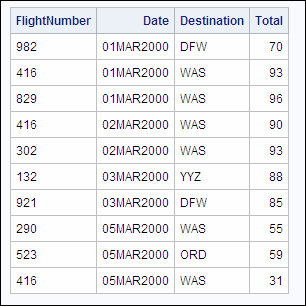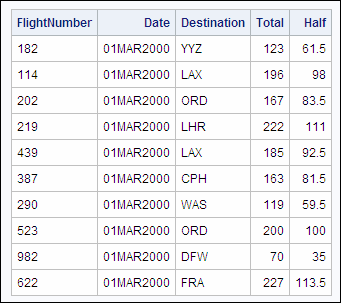Subsetting Rows By Using Calculated Values
Understanding How PROC SQL Processes Calculated Columns
You should already know how to define a new column by
using the SELECT clause and performing a calculation. For example,
the following PROC SQL query creates the new column Total by adding
the values of three existing columns: Boarded, Transferred, and Nonrevenue:
proc sql outobs=10;
select flightnumber, date, destination,
boarded + transferred + nonrevenue
as Total
from sasuser.marchflightsYou can also use a calculated
column in the WHERE clause to subset rows. However, because of how
SQL queries are processed, you cannot just specify the column alias
in the WHERE clause. To see what happens, we take the preceding PROC
SQL query and add a WHERE clause in the SELECT statement to reference
the calculated column Total, as shown below:
proc sql outobs=10;
select flightnumber, date, destination,
boarded + transferred + nonrevenue
as Total
from sasuser.marchflights
where total < 100;When this query is executed,
the following error message is displayed in the SAS log.
519 proc sql outobs=10;
520 select flightnumber, date, destination,
521 boarded + transferred + nonrevenue
522 as Total
523 from sasuser.marchflights
524 where total < 100;
ERROR: The following columns were not found in the contributing tables: total. |
This error message is
generated because, in SQL queries, the WHERE clause is processed before
the SELECT clause. The SQL processor looks in the table for each column
named in the WHERE clause. The table Sasuser.Marchflights does not
contain a column named Total, so SAS generates an error message.
Using the Keyword CALCULATED
When
you use a column alias in the WHERE clause to refer to a calculated
value, you must use the keyword CALCULATED along with the alias. The
CALCULATED keyword informs PROC SQL that the value is calculated within
the query. Now, the PROC SQL query looks like this:
proc sql outobs=10;
select flightnumber, date, destination,
boarded + transferred + nonrevenue
as Total
from sasuser.marchflights
where calculated total < 100;This query executes
successfully and produces the following output.
Note: As an alternative to using
the keyword CALCULATED, repeat the calculation in the WHERE clause.
However, this method is inefficient because PROC SQL has to perform
the calculation twice. In the preceding query, the alternate WHERE
statement would be:
where boarded + transferred + nonrevenue <100;You can also use the
CALCULATED keyword in other parts of a query. In the following example,
the SELECT clause calculates the new column Total and then calculates
a second new column based on Total. To create the second calculated
column, you have to specify the keyword CALCULATED in the SELECT clause.
proc sql outobs=10;
select flightnumber, date, destination,
boarded + transferred + nonrevenue
as Total,
calculated total/2 as Half
from sasuser.marchflights;This query produces
the following output.
Note: The CALCULATED keyword is
a SAS enhancement and is not specified in the ANSI Standard for SQL.
..................Content has been hidden....................
You can't read the all page of ebook, please click here login for view all page.


